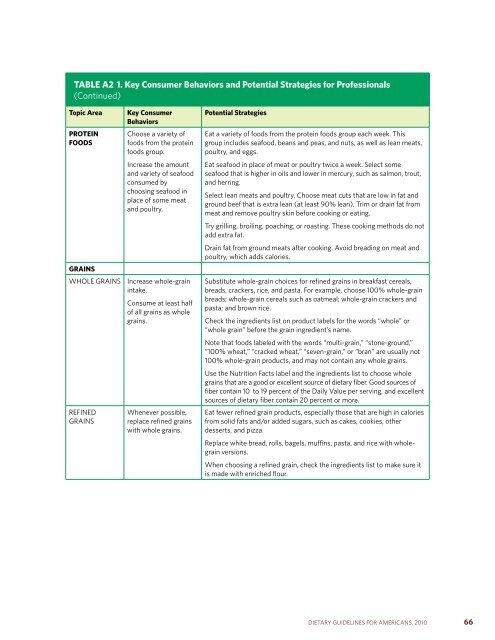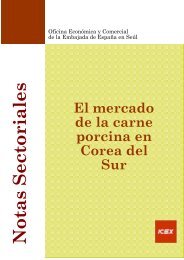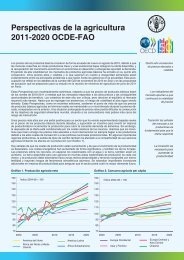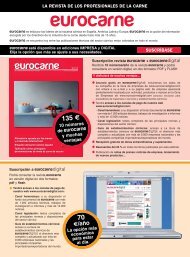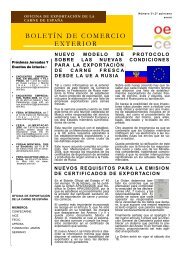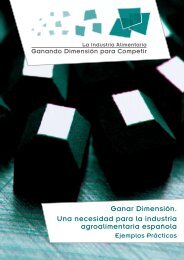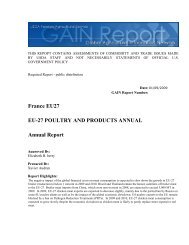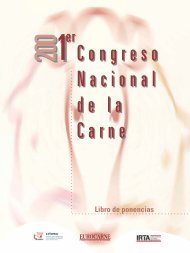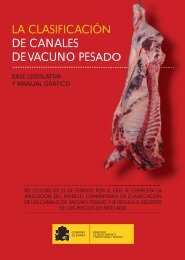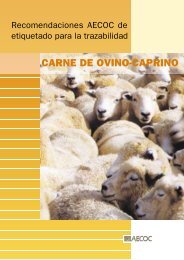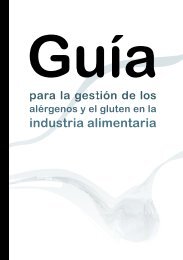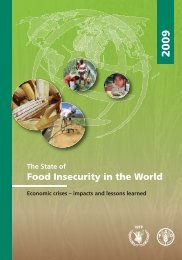taBle a2 - 1. key consumer Behaviors and Potential strategies <strong>for</strong> Professionals(Continued)topic areavegetaBlesfruitsMilk andMilkProducts(DAIRYPRODUCTS)key consumerBehaviorsIncrease vegetableintake.Eat re<strong>com</strong>mendedamounts ofvegetables, andinclude a varietyof vegetables,especially darkgreenvegetables,red and orangevegetables, andbeans and peas.Increase fruit intake.Eat re<strong>com</strong>mendedamounts of fruitsand choose a varietyof fruits. Choosewhole or cut-upfruits more oftenthan fruit juice.Increase intake offat-free or lowfatmilk and milkproducts, such asmilk, yogurt, cheese,and <strong>for</strong>tified soybeverages. aReplace higherfat milk and milkproducts with lowerfat options.Potential strategiesInclude vegetables in meals and in snacks. Fresh, frozen, and canned vegetablesall count. When eating canned vegetables, choose those labeled as reducedsodium or no salt-added.Add dark-green, red, and orange vegetables to soups, stews, casseroles, stirfries,and other main and side dishes. Use dark leafy greens, such as romainelettuce and spinach, to make salads.Focus on dietary fiber—beans and peas are a great source. Add beans or peas tosalads (e.g., kidney or garbanzo beans), soups (e.g., split peas or lentils), andside dishes (e.g., baked beans or pinto beans), or serve as a main dish.Keep raw, cut-up vegetables handy <strong>for</strong> quick snacks. If serving with a dip,choose lower calorie options, such as yogurt-based dressings or hummus,instead of sour cream or cream cheese-based dips.When eating out, choose a vegetable as a side dish. With cooked vegetables,request that they be prepared with little or no fat and salt. With salads, ask <strong>for</strong>the dressing on the side so you can decide how much you use.When adding sauces, condiments, or dressings to vegetables, use small amountsand look <strong>for</strong> lower calorie options (e.g., reduced-fat cheese sauce or fat-freedressing). Sauces can make vegetables more appealing, but often add extra calories.Use fruit as snacks, salads, or desserts.Instead of sugars, syrups, or other sweet toppings, use fruit to top foods such ascereal and pancakes.Enjoy a wide variety of fruits, and maximize taste and freshness by adaptingyour choices to what is in season.Keep rinsed and cut-up fruit handy <strong>for</strong> quick snacks.Use canned, frozen, and dried fruits, as well as fresh fruits. Unsweetened fruitor fruit canned in 100% juice is the better choice because light or heavy syrupadds sugar and calories.Select 100% fruit juice when choosing juices.Drink fat-free (skim) or low-fat (1%) milk. If you currently drink whole milk,gradually switch to lower fat versions. This change will cut calories, but will notreduce calcium or other essential nutrients.When drinking beverages, such as cappuccino or latte, request fat-free orlow-fat milk.Use fat-free or low-fat milk on cereal and oatmeal. Top fruit salads with fat-freeor low-fat yogurt.When recipes such as dip call <strong>for</strong> sour cream, substitute plain fat-free orlow-fat yogurt.When selecting cheese, choose low-fat or reduced-fat versions.If you are lactose intolerant, try lactose-free milk, drink smaller amounts of milkat a time, or try <strong>for</strong>tified soy beverages.Choose fat-free or low-fat milk or yogurt more often than cheese. Milk and yogurtare better sources of potassium and are lower in sodium than most cheeses.Also, most milk is <strong>for</strong>tified with vitamin D.a. Fortified soy beverages have been marketed as “soymilk,” a product name consumers could see in supermarkets and consumer materials. However,FDA’s regulations do not contain provisions <strong>for</strong> the use of the term soymilk. There<strong>for</strong>e, in this document, the term “<strong>for</strong>tified soy beverage” includesproducts that may be marketed as soymilk.65DIETARY GUIDELINES FOR AMERICANS, 2010
taBle a2 - 1. key consumer Behaviors and Potential strategies <strong>for</strong> Professionals(Continued)topic areaProteinfoodskey consumerBehaviorsChoose a variety offoods from the proteinfoods group.Increase the amountand variety of seafoodconsumed bychoosing seafood inplace of some meatand poultry.grainsWHOLE GRAINS Increase whole-grainintake.Consume at least halfof all grains as wholegrains.REFINEDGRAINSWhenever possible,replace refined grainswith whole grains.Potential strategiesEat a variety of foods from the protein foods group each week. Thisgroup includes seafood, beans and peas, and nuts, as well as lean meats,poultry, and eggs.Eat seafood in place of meat or poultry twice a week. Select someseafood that is higher in oils and lower in mercury, such as salmon, trout,and herring.Select lean meats and poultry. Choose meat cuts that are low in fat andground beef that is extra lean (at least 90% lean). Trim or drain fat frommeat and remove poultry skin be<strong>for</strong>e cooking or eating.Try grilling, broiling, poaching, or roasting. These cooking methods do notadd extra fat.Drain fat from ground meats after cooking. Avoid breading on meat andpoultry, which adds calories.Substitute whole-grain choices <strong>for</strong> refined grains in breakfast cereals,breads, crackers, rice, and pasta. For example, choose 100% whole-grainbreads; whole-grain cereals such as oatmeal; whole-grain crackers andpasta; and brown rice.Check the ingredients list on product labels <strong>for</strong> the words “whole” or“whole grain” be<strong>for</strong>e the grain ingredient’s name.Note that foods labeled with the words “multi-grain,” “stone-ground,”“100% wheat,” “cracked wheat,” “seven-grain,” or “bran” are usually not100% whole-grain products, and may not contain any whole grains.Use the Nutrition Facts label and the ingredients list to choose wholegrains that are a good or excellent source of dietary fiber. Good sources offiber contain 10 to 19 percent of the Daily Value per serving, and excellentsources of dietary fiber contain 20 percent or more.Eat fewer refined grain products, especially those that are high in caloriesfrom solid fats and/or added sugars, such as cakes, cookies, otherdesserts, and pizza.Replace white bread, rolls, bagels, muffins, pasta, and rice with wholegrainversions.When choosing a refined grain, check the ingredients list to make sure itis made with enriched flour.DIETARY GUIDELINES FOR AMERICANS, 2010 66


